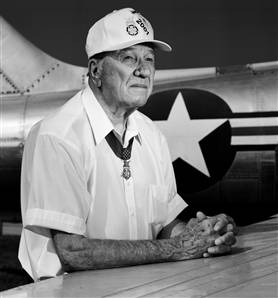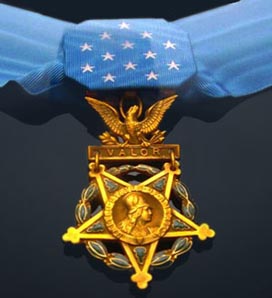Ed W. Freeman


|
You're a 19 year old kid. You're critically wounded & dying in the jungle somewhere in the Central Highlands of Viet Nam. It's November 11,1967. LZ (landing zone) X-ray. Your unit is outnumbered 8-1 and the enemy fire is so intense, from 100 yards away, that your CO (commanding officer) has ordered the MedEvac helicopters to stop coming in. You're lying there, listening to the enemy machine guns and you know you're not getting out. Your family is half way around the world; 12,000 miles away, and you'll never see them again.
As the world starts to fade in and out, you know this is the day.
Captain Ed Freeman is coming in for you. He's not MedEvac so it's not his job, but he heard the radio call and decided he's flying his Huey down into the machine gun fire anyway. Even after the MedEvacs were ordered not to come. He's coming anyway. And he drops it in and sits there in the machine gun fire, as they load 3 of you at a time on board. Then he flies you up and out through the gunfire to the doctors and nurses and safety. And, he kept coming back!! 13 more times!! Until all the wounded were out. No one knew until the mission was over that the Captain had been hit 4 times in the legs and left arm. He took 29 of you and your buddies out that day. Some would not have made it without the Captain and his Huey.
Medal of Honor Recipient, Captain Ed Freeman, United States Air Force; |
|
ED W. FREEMAN Captain, U.S. Army Company A, 229th Assault Helicopter Battalion, 1st Cavalry Division (Airmobile)
By the time the Korean War broke out, Ed Freeman was a master sergeant in the Army Engineers, but he fought in Korea as an infantryman. He began flying fixed-wing aircraft, then switched to helicopters. By 1965, when he was sent to Vietnam, he had thousands of hours’ flying time in choppers. He was assigned to the 1st Cavalry Division (Airmobile), second in command of a sixteen-helicopter unit responsible for carrying infantrymen into battle. On November 14, 1965, Freeman’s helicopters carried a battalion into the Ia Drang Valley for what became the first major confrontation between large forces of the American and North Vietnamese armies. Back at base, Freeman and the other pilots received word that the GIs they had dropped off were taking heavy casualties and running low on supplies. In fact, the fighting was so fierce that medevac helicopters refused to pick up the wounded. When the commander of the helicopter unit asked for volunteers to fly into the battle zone, Freeman alone stepped forward. He was joined by his commander, and the two of them began several hours of flights into the contested area. Because their small emergency-landing zone was just one hundred yards away from the heaviest fighting, their unarmed and lightly armored helicopters took several hits. In all, Freeman carried out fourteen separate rescue missions, bringing in water and ammunition to the besieged soldiers and taking back dozens of wounded, some of whom wouldn’t have survived if they hadn’t been evacuated. Freeman left Vietnam in 1966 and retired from the Army the following year. He flew helicopters another twenty years for the Department of the Interior, herding wild horses, fighting fires, and performing animal censuses. Then he retired altogether. In the aftermath of the Ia Drang battle, his commanding officer, wanting to recognize Freeman’s valor, proposed him for the Medal of Honor. But the two-year statute of limitations on these kinds of recommendations had passed, and no action was taken. Congress did away with that statute in 1995, and Freeman was finally awarded the medal by President George W. Bush on July 16, 2001. Freeman was back at the White House a few months later for the premiere of We Were Soldiers, a 2002 feature film that depicted his role in the Ia Drang battle. As he was filing out of the small White House theater, the president approached him, saluted, and shook his hand. “Good job, Too Tall,” he said. |
|
Medal of Honor recipient Ed Freeman, died at the age of 80 in Boise, Idaho on August 20, 2008.
|
|
Place and date: Ia Drang Valley, Republic of Vietnam, 14 November 1965 Born: 1928
Citation: |